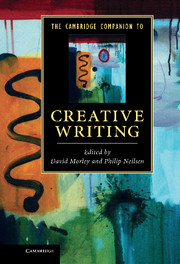Book contents
- Frontmatter
- 1 Introduction
- PART I GENRES AND TYPES
- 2 A writing lesson: the three flat tyres and the outer story
- 3 In conversation: a new approach to teaching long fiction
- 4 Genre and speculative fiction
- 5 Writing drama
- 6 Poetics and poetry
- 7 Travel writing
- 8 Creative writing and new media
- 9 Creative translation
- 10 Life writing
- PART II TOPICS
- Further reading
- Other titles in this series
- Index
3 - In conversation: a new approach to teaching long fiction
from PART I - GENRES AND TYPES
Published online by Cambridge University Press: 28 March 2012
- Frontmatter
- 1 Introduction
- PART I GENRES AND TYPES
- 2 A writing lesson: the three flat tyres and the outer story
- 3 In conversation: a new approach to teaching long fiction
- 4 Genre and speculative fiction
- 5 Writing drama
- 6 Poetics and poetry
- 7 Travel writing
- 8 Creative writing and new media
- 9 Creative translation
- 10 Life writing
- PART II TOPICS
- Further reading
- Other titles in this series
- Index
Summary
Long fiction and the traditional writing programme
Novelists write novels to evoke the world as they see it, or to move beyond received ideas to understand that world more deeply. They may draw from life, using words, voices and narratives that come with long histories attached, but (if they have literary aspirations) the trajectory they take will be theirs and theirs alone. How to teach such a difficult and fragile art? How to encourage students to go their own way without forcing them down the paths forged by other writers or (even worse) imposed by other cultures?
Creative writing programmes first began in the United States; it is not surprising, therefore, that they reflect American cultural attitudes. The traditional fiction workshop, which continues to sit at the heart of most writing programmes, requires that all students submit work to be scrutinised on a rota basis by the entire class. The expectation is that a monthly dose of group criticism will toughen them up, fostering a pioneering independence of mind. But it can be a brutalising experience, even in the United States. In cultures where discourse traditionally proceeds along less combative lines, it can be entirely inappropriate. If students must defend unfinished work before a committee of peers, they may opt for safe writing, concealing all that makes their imaginations unique, and stunting any idea that might cause consternation. The challenge being issued to us is to use the physical process and world of the outer story (plot/motor) to discover the inner story (character/freight). We don’t know the characters, we only know we have a flat tyre and we will use that problem to find our way towards what we do not know. (There are three examples included below.)
- Type
- Chapter
- Information
- The Cambridge Companion to Creative Writing , pp. 24 - 36Publisher: Cambridge University PressPrint publication year: 2012



